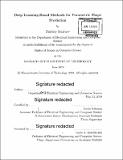| dc.contributor.advisor | Justin Solomon. | en_US |
| dc.contributor.author | Smirnov, Dmitriy,S.M.Massachusetts Institute of Technology. | en_US |
| dc.contributor.other | Massachusetts Institute of Technology. Department of Electrical Engineering and Computer Science. | en_US |
| dc.date.accessioned | 2019-11-04T20:23:24Z | |
| dc.date.available | 2019-11-04T20:23:24Z | |
| dc.date.copyright | 2019 | en_US |
| dc.date.issued | 2019 | en_US |
| dc.identifier.uri | https://hdl.handle.net/1721.1/122770 | |
| dc.description | Thesis: S.M., Massachusetts Institute of Technology, Department of Electrical Engineering and Computer Science, 2019 | en_US |
| dc.description | Cataloged from PDF version of thesis. | en_US |
| dc.description | Includes bibliographical references (pages 67-76). | en_US |
| dc.description.abstract | Many tasks in graphics and vision demand machinery for converting shapes into representations with sparse sets of parameters; these representations facilitate rendering, editing, and storage. When the source data is noisy or ambiguous, however, artists and engineers often manually construct such representations, a tedious and potentially time-consuming process. While advances in deep learning have been successfully applied to noisy geometric data, the task of generating parametric shapes has so far been difficult for these methods. In this thesis, we consider the task of deep parametric shape prediction from two distinct angles. First, we propose a new framework for predicting parametric shape primitives using distance fields to transition between parameters like control points and input data on a raster grid. We demonstrate efficacy on 2D and 3D tasks, including font vectorization and surface abstraction. Second, we look at the problem of sketch-based modeling. Sketch-based modeling aims to model 3D geometry using a concise and easy to create but extremely ambiguous input: artist sketches. While most conventional sketch-based modeling systems target smooth shapes and put manually-designed priors on the 3D shapes, we present a system to infer a complete man-made 3D shape, composed of parametric surfaces, from a single bitmap sketch. In particular, we introduce our parametric representation as well as several specially designed loss functions. We also propose a data generation and augmentation pipeline for sketch. We demonstrate the efficacy of our system on a gallery of synthetic and real sketches as well as via comparison to related work. | en_US |
| dc.description.sponsorship | "Supported by the National Science Foundation Graduate Research Fellowship under Grant No. 1122374, the Toyota-CSAIL Joint Research Center, and the Skoltech-MIT Next Generation Program" | en_US |
| dc.description.statementofresponsibility | by Dmitriy Smirnov. | en_US |
| dc.format.extent | 76 pages | en_US |
| dc.language.iso | eng | en_US |
| dc.publisher | Massachusetts Institute of Technology | en_US |
| dc.rights | MIT theses are protected by copyright. They may be viewed, downloaded, or printed from this source but further reproduction or distribution in any format is prohibited without written permission. | en_US |
| dc.rights.uri | http://dspace.mit.edu/handle/1721.1/7582 | en_US |
| dc.subject | Electrical Engineering and Computer Science. | en_US |
| dc.title | Deep learning-based methods for parametric shape prediction | en_US |
| dc.type | Thesis | en_US |
| dc.description.degree | S.M. | en_US |
| dc.contributor.department | Massachusetts Institute of Technology. Department of Electrical Engineering and Computer Science | en_US |
| dc.identifier.oclc | 1124958251 | en_US |
| dc.description.collection | S.M. Massachusetts Institute of Technology, Department of Electrical Engineering and Computer Science | en_US |
| dspace.imported | 2019-11-04T20:23:23Z | en_US |
| mit.thesis.degree | Master | en_US |
| mit.thesis.department | EECS | en_US |
